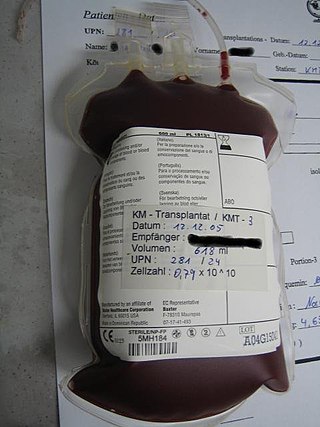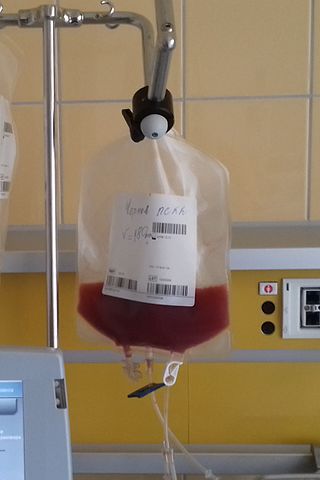Related Research Articles

Hematopoietic stem-cell transplantation (HSCT) is the transplantation of multipotent hematopoietic stem cells, usually derived from bone marrow, peripheral blood, or umbilical cord blood in order to replicate inside of a patient and to produce additional normal blood cells. It may be autologous, allogeneic or syngeneic.

Graft-versus-host disease (GvHD) is a syndrome, characterized by inflammation in different organs. GvHD is commonly associated with bone marrow transplants and stem cell transplants.

A myeloid sarcoma is a solid tumor composed of immature white blood cells called myeloblasts. A chloroma is an extramedullary manifestation of acute myeloid leukemia; in other words, it is a solid collection of leukemic cells occurring outside of the bone marrow.
Leukapheresis is a laboratory procedure in which white blood cells are separated from a sample of blood. It is a specific type of apheresis, the more general term for separating out one particular constituent of blood and returning the remainder to the circulation.

Fludarabine is a purine analogue and antineoplastic agent. It is generally used as its 5-O-phosphorylated form known as fludarabine phosphate, sold under the brand name Fludara among others. It is a chemotherapy medication used in the treatment of leukemia and lymphoma. These include chronic lymphocytic leukemia, non-Hodgkin's lymphoma, acute myeloid leukemia, and acute lymphocytic leukemia. It is given by injection into a vein or by mouth.

Acute myeloid leukemia (AML) is a cancer of the myeloid line of blood cells, characterized by the rapid growth of abnormal cells that build up in the bone marrow and blood and interfere with normal blood cell production. Symptoms may include feeling tired, shortness of breath, easy bruising and bleeding, and increased risk of infection. Occasionally, spread may occur to the brain, skin, or gums. As an acute leukemia, AML progresses rapidly, and is typically fatal within weeks or months if left untreated.
The National Marrow Donor Program (NMDP) is a nonprofit organization founded in 1986 and based in Minneapolis, Minnesota, that operates the Be The Match Registry of volunteer hematopoietic cell donors and umbilical cord blood units in the United States.

Acute myeloblastic leukemia with maturation (M2) is a subtype of acute myeloid leukemia (AML).
Juvenile myelomonocytic leukemia (JMML) is a rare form of chronic leukemia that affects children, commonly those aged four and younger. The name JMML now encompasses all diagnoses formerly referred to as juvenile chronic myeloid leukemia (JCML), chronic myelomonocytic leukemia of infancy, and infantile monosomy 7 syndrome. The average age of patients at diagnosis is two (2) years old. The World Health Organization has included JMML as a subcategory of myelodysplastic and myeloproliferative disorders.

Peripheral blood stem cell transplantation (PBSCT), also called "Peripheral stem cell support", is a method of replacing blood-forming stem cells. Stem cells can be destroyed through cancer treatments such as chemotherapy or radiation, as well as any blood-related diseases, such as leukemia, lymphoma, neuroblastoma and multiple myeloma. PBSCT is now a much more common procedure than its bone marrow harvest equivalent due to the ease and less invasive nature of the procedure. Studies suggest that PBSCT has a better outcome in terms of the number of hematopoietic stem cell yield.
Acute myelomonocytic leukemia (AMML) is a form of acute myeloid leukemia that involves a proliferation of CFU-GM myeloblasts and monoblasts. AMML occurs with a rapid increase amount in white blood cell count and is defined by more than 20% of myeloblast in the bone marrow. It is classified under "M4" in the French-American-British classification (FAB). It is classified under "AML, not otherwise classified" in the WHO classification.
Biphenotypic acute leukaemia (BAL) is an uncommon type of leukemia which arises in multipotent progenitor cells which have the ability to differentiate into both myeloid and lymphoid lineages. It is a subtype of "leukemia of ambiguous lineage".

Childhood leukemia is leukemia that occurs in a child and is a type of childhood cancer. Childhood leukemia is the most common childhood cancer, accounting for 29% of cancers in children aged 0–14 in 2018. There are multiple forms of leukemia that occur in children, the most common being acute lymphoblastic leukemia (ALL) followed by acute myeloid leukemia (AML). Survival rates vary depending on the type of leukemia, but may be as high as 90% in ALL.
Graft-versus-tumor effect (GvT) appears after allogeneic hematopoietic stem cell transplantation (HSCT). The graft contains donor T cells that can be beneficial for the recipient by eliminating residual malignant cells. GvT might develop after recognizing tumor-specific or recipient-specific alloantigens. It could lead to remission or immune control of hematologic malignancies. This effect applies in myeloma and lymphoid leukemias, lymphoma, multiple myeloma and possibly breast cancer. It is closely linked with graft-versus-host disease (GvHD), as the underlying principle of alloimmunity is the same. CD4+CD25+ regulatory T cells (Treg) can be used to suppress GvHD without loss of beneficial GvT effect. The biology of GvT response still isn't fully understood but it is probable that the reaction with polymorphic minor histocompatibility antigens expressed either specifically on hematopoietic cells or more widely on a number of tissue cells or tumor-associated antigens is involved. This response is mediated largely by cytotoxic T lymphocytes (CTL) but it can be employed by natural killers as separate effectors, particularly in T-cell-depleted HLA-haploidentical HSCT.
The 307th Hospital of the Chinese People's Liberation Army, commonly called the 307 Hospital, is a hospital in China. It is in Fengtai District, Beijing. The hospital combines medical treatment, research, and educational studies into a comprehensive hospital, which is one of the first designated medical institutions with medical insurance coverage in Beijing. 307 Hospital of PLA is appointed as the National Clinical Hospital of Disease Control.
Huisheng Ai is the current director of both the Hematology and Radiation Therapy Departments of the 307th Hospital of Chinese People’s Liberation Army. He joined the hospital in 1983. After a short time working in various departments, he settled in the radiation and homeopathy departments, the most revered in the hospital. Huisheng Ai, Guo Mei, and the medical team developed microtransplantation treatment for leukemia.
Guo Mei is a hematologist and associate director of 307th Hospital of Chinese People’s Liberation Army and deputy director of Radiation Research Institute.
Lenzilumab is a humanized monoclonal antibody that targets colony stimulating factor 2 (CSF2)/granulocyte-macrophage colony stimulating factor (GM-CSF).
T-cell depletion (TCD) is the process of T cell removal or reduction, which alters the immune system and its responses. Depletion can occur naturally or be induced for treatment purposes. TCD can reduce the risk of graft-versus-host disease (GVHD), which is a common issue in transplants. The idea that TCD of the allograft can eliminate GVHD was first introduced in 1958. In humans the first TCD was performed in severe combined immunodeficiency patients.

Shimon Slavin is an Israeli professor of medicine. Slavin pioneered the use of immunotherapy mediated by allogeneic donor lymphocytes and innovative methods for stem cell transplantation for the cure of hematological malignancies and solid tumors, and using hematopoietic stem cells for induction of transplantation tolerance to bone marrow and donor allografts.
References
- ↑ Guo, Mei; Hu, Kai-Xun; Yu, Chang-Lin; Sun, Qi-Yun; Qiao, Jian-Hui; Wang, Dan-Hong; Liu, Guang-Xian; Sun, Wan-Jun; Wei, Li; Sun, Xue-Dong; Huang, Ya-Jing; Qiao, Jun-Xiao; Dong, Zheng; Ai, Hui-Sheng (2011). "Infusion of HLA-mismatched peripheral blood stem cells improves the outcome of chemotherapy for acute myeloid leukemia in elderly patients". Blood. 117 (3): 936–941. doi: 10.1182/blood-2010-06-288506 . PMID 20966170.
- ↑ Guo, Mei; Hu, Kai-Xun; Yu, Chang-Lin; Sun, Qi-Yun; Qiao, Jian-Hui; Wang, Dan-Hong; Liu, Guang-Xian; Sun, Wan-Jun; Wei, Li; Sun, Xue-Dong; Huang, Ya-Jing; Qiao, Jun-Xiao; Dong, Zheng; Ai, Hui-Sheng (2011). "Infusion of HLA-mismatched peripheral blood stem cells improves the outcome of chemotherapy for acute myeloid leukemia in elderly patients". Blood. 117 (3): 936–941. doi: 10.1182/blood-2010-06-288506 . PMID 20966170.
- ↑ Guo, Mei; Hu, Kai-Xun; Yu, Chang-Lin; Sun, Qi-Yun; Qiao, Jian-Hui; Wang, Dan-Hong; Liu, Guang-Xian; Sun, Wan-Jun; Wei, Li; Sun, Xue-Dong; Huang, Ya-Jing; Qiao, Jun-Xiao; Dong, Zheng; Ai, Hui-Sheng (2011). "Infusion of HLA-mismatched peripheral blood stem cells improves the outcome of chemotherapy for acute myeloid leukemia in elderly patients". Blood. 117 (3): 936–941. doi: 10.1182/blood-2010-06-288506 . PMID 20966170.
- ↑ Guo, Mei; Hu, Kai-Xun; Liu, Guang-Xian; Yu, Chang-Lin; Qiao, Jian-Hui; Sun, Qi-Yun; Qiao, Jun-Xiao; Dong, Zheng; Sun, Wan-Jun; Sun, Xue-Dong; Zuo, Hong-Li; Man, Qiu-Hong; Liu, Zhi-Qing; Liu, Tie-Qiang; Zhao, Hong-Xia; Huang, Ya-Jing; Wei, Li; Liu, Bing; Wang, Juan; Shen, Xu-Liang; Ai, Hui-Sheng (2012). "HLA-Mismatched Stem-Cell Microtransplantation as Postremission Therapy for Acute Myeloid Leukemia: Long-Term Follow-Up". Journal of Clinical Oncology. 30 (33): 4084–4090. doi: 10.1200/JCO.2012.42.0281 . PMID 23045576.
- ↑ Guo, Mei; Hu, Kai-Xun; Liu, Guang-Xian; Yu, Chang-Lin; Qiao, Jian-Hui; Sun, Qi-Yun; Qiao, Jun-Xiao; Dong, Zheng; Sun, Wan-Jun; Sun, Xue-Dong; Zuo, Hong-Li; Man, Qiu-Hong; Liu, Zhi-Qing; Liu, Tie-Qiang; Zhao, Hong-Xia; Huang, Ya-Jing; Wei, Li; Liu, Bing; Wang, Juan; Shen, Xu-Liang; Ai, Hui-Sheng (2012). "HLA-Mismatched Stem-Cell Microtransplantation as Postremission Therapy for Acute Myeloid Leukemia: Long-Term Follow-Up". Journal of Clinical Oncology. 30 (33): 4084–4090. doi: 10.1200/JCO.2012.42.0281 . PMID 23045576.
- ↑ Cignetti, A.; Ruella, M.; Elia, A.; Tassi, V.; Redoglia, V.; Gottardi, D.; Tarella, C. (2013). "Haploidentical cellular therapy in elderly patients with acute myeloid leukemia: Description of its use in high risk patients". American Journal of Hematology. 88 (8): 720–721. doi:10.1002/ajh.23483. hdl: 2434/663300 . PMID 23686413.
- ↑ Freireich, EJ; Lichtiger, B; Mattiuzzi, G; Martinez, F; Reddy, V; Kyle Wathen, J (2013). "A prospective, randomized, double-blind study, comparing unirradiated to irradiated white blood cell transfusions in acute leukemia patients". Leukemia. 27 (4): 861–5. doi:10.1038/leu.2012.301. PMC 3626021 . PMID 23072780.
- ↑ Forés, R; Dorado, N; Vilches, C; Regidor, C; García-Marco, JA; de Pablo, R; de Laiglesia, A; Lario, A; Piris, M; Cabrera, JR (2014). "HLA-partially matched cellular therapy (stem-cell microtransplantation) for acute myeloid leukaemia: description of four cases". British Journal of Haematology. 165 (4): 580–581. doi: 10.1111/bjh.12771 . PMID 24666200.